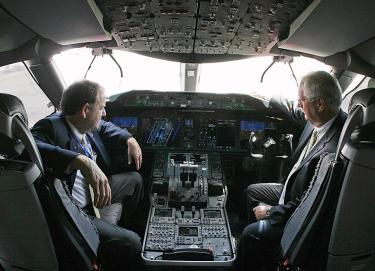A
potential double-stretched 787-10 variant depends more on what Boeing
decides to do with the 777 more than anything else.
 Not
for the first time, talk about a double-stretched 787 has entered the
fray only this time, Boeing’s decision to establish a dedicated
development team for the 777 puts the decision making into a rather
grey area. Some
of this is compounded by the ever-growing uncertainty over the rival
Airbus A350-1000, which thus far is failing to make the grade on
paper (or sales) against the 777-300ER.
Not
for the first time, talk about a double-stretched 787 has entered the
fray only this time, Boeing’s decision to establish a dedicated
development team for the 777 puts the decision making into a rather
grey area. Some
of this is compounded by the ever-growing uncertainty over the rival
Airbus A350-1000, which thus far is failing to make the grade on
paper (or sales) against the 777-300ER.
There
is equally the possibility that Boeing could do both moves and
squeeze the big Airbus jet – it is a poor selling model in contrast
to other 777, A350 and 787 variants. For
whatever its worth, there’s more chance of a 787-10 and/or enhanced
777 emerging than there is of a so-called 150 seat CSeries.
 Boeing
hopes to make a decision this year on the 787-10 and aims to ensure
that this larger-capacity 787 avoids cannibalizing sales of the 777,
another family of Boeing aircraft that also may be getting new
models, the 777-8X and 777-9X. While
the 777 looks more than likely to benefit from a revamp rather than a
full overhaul, this is paced more with the fact that the larger
A350-1000 is still undefined and program sources attribute
significant issues with the baseline A350-900 that have to be ironed
out first before a stretch can happen, much less meet the advertised
specifications Airbus has listed.
Boeing
hopes to make a decision this year on the 787-10 and aims to ensure
that this larger-capacity 787 avoids cannibalizing sales of the 777,
another family of Boeing aircraft that also may be getting new
models, the 777-8X and 777-9X. While
the 777 looks more than likely to benefit from a revamp rather than a
full overhaul, this is paced more with the fact that the larger
A350-1000 is still undefined and program sources attribute
significant issues with the baseline A350-900 that have to be ironed
out first before a stretch can happen, much less meet the advertised
specifications Airbus has listed.  Boeing
is loathe to grow the 787 into 777 territory – a stretch too far,
and you end up with a useless airplane like the A340-600 which trades
passengers and payload for range and is saddled with higher costs.
Boeing
is loathe to grow the 787 into 777 territory – a stretch too far,
and you end up with a useless airplane like the A340-600 which trades
passengers and payload for range and is saddled with higher costs.
A
second stretch of the 787 would also raise engine thrust issues,
affecting performance. As Boeing studies its options with 777, the
company feels that a lower cost approach to improving that would be
far more beneficial to countering the perceived angst any A350-1000
could cause.
Boeing
Commercial Airplanes CEO Jim Albaugh said, “We will do the 787-10
by all likelihood. We’re now working through design concepts.
Assuming the customer interest is there, later this year [a decision
will be made], and we will have something to offer toward the end of
the year.” He says the 787-10 will have a shorter range than the -9
but will be able to carry 40 more passengers, so “the economics are
very good.”
The
fact that the 787-10 is a stretch of the 787-9 means it will be in
the realm of the 777 in terms of seating capacity. Albaugh, however,
suggests otherwise. “We think we’ve got a good separation between
the models. There’s 15% separation between the models. We’ve
spread the sizing between them, so we don’t cannibalize any one
aircraft.”
 There
have been some reports about a 777-8LX model, which promises more
range, but Albaugh is dismissive. “I’ve seen something on a chart
mentioning that, but I am focused on the 777-9X and 777-8X,” he
says, referring to the new stretched version of the 777-300ER and
777-200, respectively. Albaugh was speaking to Aviation Week in
Singapore yesterday during a media roundtable.
There
have been some reports about a 777-8LX model, which promises more
range, but Albaugh is dismissive. “I’ve seen something on a chart
mentioning that, but I am focused on the 777-9X and 777-8X,” he
says, referring to the new stretched version of the 777-300ER and
777-200, respectively. Albaugh was speaking to Aviation Week in
Singapore yesterday during a media roundtable.
He
says the 777-8X and 777-9X are hugely important to the company.
Boeing sold 200 777s last year, and the aircraft is unbeatable in
terms of efficiency, asserts Albaugh. But he also says Boeing is
mindful of the fact that Airbus is planning the A350-1000, and
declines to disclose details on the 777-9X, except to say “it will
be a significant improvement over the 777-300ER.”
As
for the 737 MAX, Albaugh says, “I hope we can have a couple of
thousand orders before we deliver the first aircraft.” Boeing
already has secured firm orders for the 737-8 and 737-9. Albaugh says
it also has secured a 737-7 customer, but has yet to disclose who
that is.
Albaugh
declines to say when the 737 MAX specifications will be locked, but
asserts they are already effectively firmed up because Boeing is
giving MAX customers guarantees when it comes to the specs. He also
says, “I don’t want to over-promise and under-deliver. I want to
ensure that it is on spec and delivered on time.” Boeing has
learned from the lessons of the 787 program, he adds.






